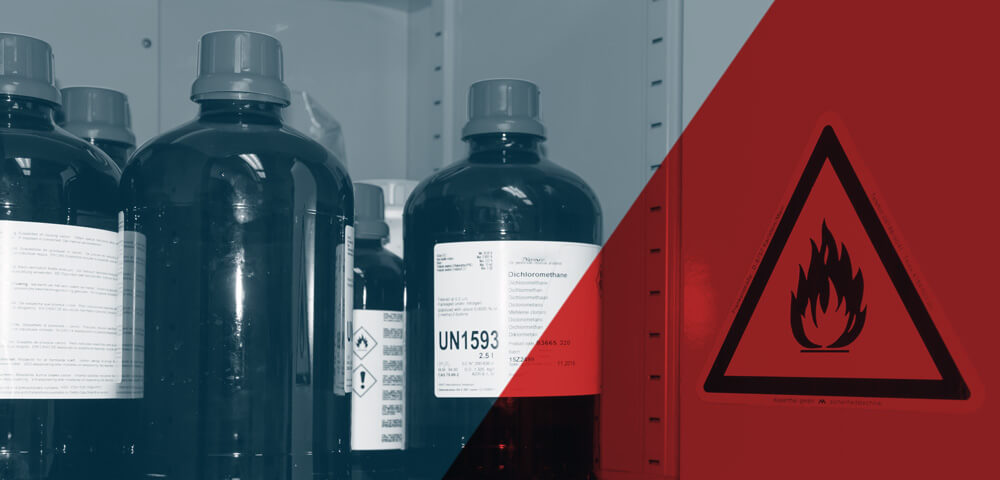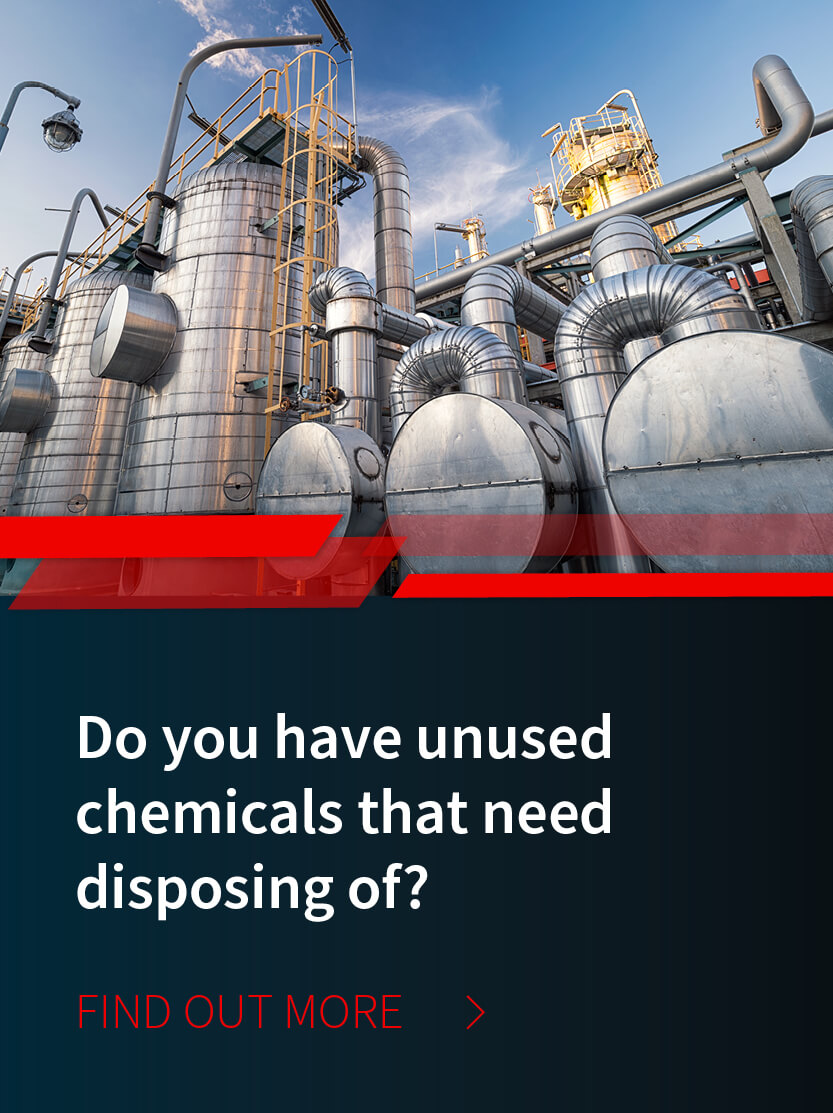
/ IN THIS BLOG
01 / Introduction
One might reasonably conceive the art & science of chemical waste disposal as having two distinct elements. On one hand there’s treatment—either to detoxify a chemical waste or destroy it completely. And then there’s storage, which typically includes landfills, waste piles, ponds, lagoons, and in some cases, “deep-well injections.”
A comprehensive strategy for chemical waste management will include both elements, because subsequent even to the most robust treatment, there will still be residues or lingering wastes that will require safe & legal storage.
This blog will serve as an introduction to both Treatment and Storage. But as in all things concerning chemical waste collection and its disposal: it’s crucial to get expert advice. That said…
02 / Treatment methods for chemical waste management
Subsequent to chemical waste collection, treatment for chemical waste disposal is accomplished by one of four processes:
Biological methods. Commonly used for oil & gas industrial wastes, biological methods for chemical waste management exploit microbe “consortiums” that survive by consuming the secondary metabolites of other species around them. (Common cesspools use this technology.)
While an individual species of microbe can’t fully break down a complex molecule, it can do so partially. Then, some of what’s left might be broken down by a second species, followed by a third, and so on. Thereby, the hazardous waste is reduced to safer byproducts by the different microbes “in consortia.”
The use of microbe consortiums is closely related to “landfarming,” wherein a chemical waste is mixed with surface soil on a tract of land dedicated to waste management. Nutrients might be added to encourage the growth of microbe consortiums; and in some cases genetically‑engineered bacteria might be introduced.
However, landfarming is problematic. It requires a lot of land, and it’s difficult to control the conditions necessary for rapid biological degradation of contaminants.
Among other drawbacks, the presence of metal ions in the waste might be poisonous to the microbe consortiums, and ions can leach into the ground. Also, such common contaminants as creosote, pentachlorophenol (PCP), and Bunker C oil are not effectively broken down by microbes.
Chemical methods. There are basically four chemical methods used to treat hazardous waste for chemical waste disposal:
Ion exchange involves the exchange of ions between an insoluble solid and a solution that surrounds it, which is the familiar process used to “soften” water. But per the EPA, in the realm of chemical waste management, ion exchange is used to extract toxic heavy metals such as lead, mercury, and chromium from a chemical waste.
Precipitation is the process of adding reagents to a chemical waste to induce a chemical reaction that will convert dissolved metals into solid particles, which can then be chemically aggregated for removal by filtration or sedimentation.
Reduction/oxidation (aka “redox”) is a reaction that transfers electrons from one compound to another. One reactant loses electrons (i.e. oxidation) while the other gains. Thereby, a hazardous contaminant can be made more stable, less mobile, and/or inert, and thereby nonhazardous.
Neutralization occurs when an inorganic acid is mixed with a base in an aqueous solution so that each cancels the corrosive characteristics of the other. Only water remains after the reaction, along with common salt compounds [e.g. sodium chloride (common salt) and potassium sulfate].
Physical methods. Physical treatment for chemical waste management aims to reduce the volume of a chemical waste (i.e. the amount of space it takes up) by concentrating or solidifying it. Technologies include evaporation, sedimentation, flotation, and filtration.
Another method is called “solidification.” This involves encapsulating waste in concrete, asphalt, or plastic to create a solid mass that won’t leach into the soil. Or a chemical waste might be mixed with lime, fly ash, and water to form a concrete-like material.
Thermal methods. Regarded by the EPA as the best demonstrated available technology (BDAT) for most organic hazardous waste, “thermal” is the most common type of chemical waste disposal in the United States. Specialized tools and furnaces—regulated by the RCRA—are employed to incinerate hazardous wastes at extremely high temperatures, turning them into lesser amounts of solids, liquids, or sludges
03 / Storage methods for chemical waste collection and management
As was mentioned previously, even after the most robust treatment, residues and lingering wastes will likely remain. And even though they might be less toxic than their chemical antecedents, they’ll nonetheless require safe & legal storage. Generally, there are three options. As to what’s best for your particular enterprise, make sure to get expert advice. They are:
Land storage. Also called “surface storage,” this is most prevalent solution for storing residual waste because it's relatively easy and affordable. It includes the afore-mentioned waste piles, ponds, and lagoons, which nowadays are engineered to minimize the risk of leak or erosion into the surrounding environment.
But historically, rules have been inconsistent, so many older land storage sites are the subjects of enviro-controversies and in need of cleanup & remediation. As you’re responsible for any hazardous waste you generate from “cradle-to-grave,” it’s imperative to ensure that your particular kind of residual waste is going to a reputable facility that’s properly “permitted” to handle it. Again, it’s crucial to get expert advice.
Secure landfills. Most commonly used for storing untreated hazardous waste, there are two kinds:
Purpose-designed ground depressions specially engineered to maintain a ten-foot separation between their double-lined bottoms and the underlying bedrock or groundwater table
Huge above-ground sausage-shaped structures that might be thought of as giant double-lined bathtubs
Either kind can fail in two ways: leaking from the bottom or overflowing from the top. And so various systems- and groundwater-monitoring instrumentation is mandated to ensure that neither happens. As a hazmat generator, the ultimate responsibility to ensure these technical requirements are satisfied ultimately rests with you, making it imperative to get expert advice.
Deep-well injection. This process uses high-pressure to impel chemical waste through steel casings and deeply underground, from 15-thousand to more than 30-thousand feet below the surface, under multiple layers of impermeable rock, and safely beneath drinking water aquifers. Thereby, this process can quickly remove large volumes of chemical waste.
However, while relatively inexpensive—as the waste is stored underground—there’s risk to groundwaters should something go wrong. But where the geology is favorable and the risk commensurately small, deep-well injection provides a long-term solution that can last for decades, and with relatively lower operational & maintenance costs.
04 / Summary advice for chemical waste collection and disposal guidelines
Chemical waste is the inevitable byproduct of many commercial, industrial, medical, and laboratory processes. Consider: pharmaceutical manufacturing—alone—produces approximately 212.50 million annual pounds of chemical waste. So it’s no wonder that chemical waste disposal per se is of specific concern to the EPA, not to mention a raft of local and state regulatory agencies.
So as in all matters of hazardous waste disposal—it’s crucial to get expert advice. Meantime, heed these imperatives:
Store waste chemicals in containers that won’t degrade with exposure to sunlight or the chemical itself.
Keep all chemical wastes separated. Don’t have untrained staff making ad hoc decisions about which might be compatible with the other.
Post chemical abbreviation sheets in conspicuous places so that employees are certain about what’s inside various storage containers.
Designate & label storage areas where food, flammables, and other specific substances should not be introduced.
Label storage containers with important information, such as when received, opened, tested, etc.
Keep an inventory of inhouse chemical wastes awaiting hazardous waste disposal.
And as always: thank you for reading our blog!
Robert Losurdo
President, COO








